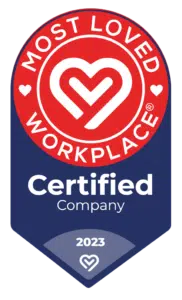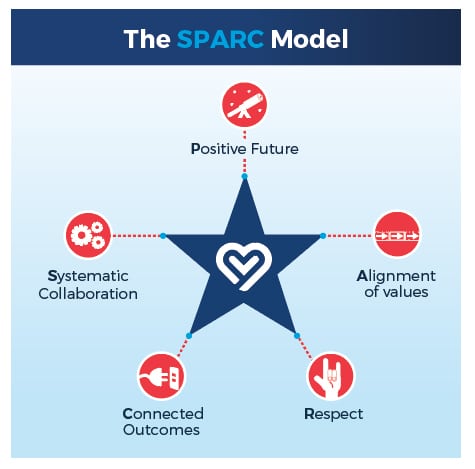ICYMI—Kickstart 2024 As A Most Loved Workplace® With Exciting New Capabilities, Education, And Data Insights To Make 2024 Your Best Year Yet
7 min. Read
In case you missed it, let’s dive into how you can kickstart 2024 as a Most Loved Workplace® by leveraging exciting new capabilities, education, and data insights to make this year your organization’s best yet. This approach is about feeling good and driving tangible business outcomes through talent strategies that focus on development, engagement, and culture.
Table of Contents
1. Embracing a Growth Mindset for 2024
To start, adopting a growth mindset within your organization is crucial. This shift in thinking can significantly improve employee retention, performance, and productivity. Rather than solely focusing on financial growth, consider how developing your workforce can enhance workplace culture and drive positive change.
Developing a Learning Culture
Creating a learning culture can foster a growth mindset. Incentivize employees to develop new skills and knowledge and provide continuous learning and development opportunities.
Encouraging Innovation and Adaptability
Embracing a growth mindset also means encouraging innovation and adaptability. Encourage employees to think creatively and adapt to new challenges and opportunities, fostering a culture of continuous improvement and growth.
Promoting a Positive Mindset
Promote a positive mindset among employees by recognizing and celebrating their achievements, no matter how small. Encourage a “can-do” attitude and create an environment that deems failure an opportunity for growth and learning.

Building a Thriving Workplace Culture!
Discover how to leverage the right technology and implement a proactive strategy that cultivates talent and facilitates team collaboration.
2. Leveraging Data Insights
One key aspect of this approach is leveraging data insights to drive decision-making. By analyzing employee feedback and survey data, you can find areas for improvement and develop actionable plans to address them. It shows your commitment to listening to your employees and your willingness to take concrete steps to improve their experience.
Utilizing Employee Feedback
Employee feedback is a valuable source of data that can provide insights into areas for improvement. Regularly collect feedback through surveys, focus groups, or one-on-one discussions, and use this data to inform decision-making and drive positive change.
Analyzing Survey Data
Carefully analyze survey data to identify trends and patterns. Look for common themes or issues that need to be addressed and develop actionable plans to tackle these challenges.
Implementing Data-Driven Solutions
Use data to develop targeted solutions to improve employee satisfaction and engagement. Whether it’s implementing new policies, providing additional training, or making changes to the work environment, use data to make decisions and measure the impact of your efforts.
3. Creating Actionable Plans
Turning survey insights into actionable plans is crucial for driving meaningful change. It involves collecting data and developing clear strategies for improvement based on that data. By involving employees in this process and showing them their feedback is being taken seriously, you can ensure ownership and engagement for a more positive workplace culture.
Setting Clear Goals and Objectives
Setting clear, attainable goals and objectives is essential when developing actionable plans. Clearly define what you want to achieve and develop a roadmap.
Assigning Responsibilities and Deadlines
Assign responsibilities for implementing the plan to specific individuals or teams and set clear deadlines for each task. It helps ensure accountability and keeps the plan on track.
Monitoring Process and Making Adjustments
Regularly check progress toward your goals and be prepared to make adjustments as needed. Be flexible and willing to modify your plan based on feedback and changing circumstances.
4. Focusing on Talent Development
 Another critical component of being a Most Loved Workplace® is a focus on talent development. Providing opportunities for growth and development benefits your employees and your organization as a whole. Investing in your employees’ skills and development can increase their engagement, productivity, and loyalty.
Another critical component of being a Most Loved Workplace® is a focus on talent development. Providing opportunities for growth and development benefits your employees and your organization as a whole. Investing in your employees’ skills and development can increase their engagement, productivity, and loyalty.Providing Growth Opportunities
Offering professional growth and development opportunities is essential for attracting and retaining top talent. Provide access to training programs, workshops, and mentorship opportunities to help employees reach their full potential.
Encouraging Career Path Planning
Encourage employees to create a career path plan that aligns with their goals and aspirations. Provide guidance and support to help them navigate their career development within the organization.
Recognizing and Rewarding Achievement
Recognize and reward people for their achievements and contributions. It boosts morale and motivates employees to continue growing and developing within the organization.
5. Prioritizing Employee Engagement
Employee engagement is also critical for creating a Most Loved Workplace®. It involves more than just providing perks and benefits; it’s about creating a work environment where employees feel valued, respected, and heard. By prioritizing employee engagement, you can create a positive workplace culture to win and retain top talent.
Fostering a Collaborative Environment
Create a collaborative work environment where people feel comfortable sharing their ideas and opinions. Encourage teamwork and communication across departments to foster a sense of belonging and engagement.
Promoting Work-Life Balance
Ensuring work-life balance is essential for employee engagement. Encourage employees to take time off when needed and promote flexible work arrangements to accommodate their personal needs.
Creating a Culture of Recognition
Recognize and appreciate people regularly for their hard work and contributions. Whether through formal awards or informal shout-outs, showing appreciation can significantly boost morale and engagement.
6. Building a Culture of Respect and Value
Finally, building a culture of respect and value is essential for becoming a Most Loved Workplace®. It means treating employees as human beings, not just resources. It involves creating a workplace where people feel respected for their contributions and valued for who they are. This culture can increase employee satisfaction and loyalty, creating a more successful organization.
Encouraging Open Communication
Promote open and honest communication within your organization. Encourage people to voice their opinions and concerns and listen actively to their feedback.
Fostering Inclusivity and Diversity
Create an inclusive and diverse place where everyone feels valued and respected. Celebrate differences and create opportunities for all employees to contribute and succeed.
Leading by Example
As leaders, it’s essential to lead by example and demonstrate respect and value for your employees. Treat every employee with dignity and respect, and create an environment where people feel valued and appreciated.
Final Word
By focusing on talent strategies that prioritize development, engagement, and culture, you can kickstart 2024 as a Most Loved Workplace®.
By embracing a growth mindset, leveraging data insights from the Workplacely platform, creating actionable plans, focusing on talent development, prioritizing employee engagement, and building a culture of respect and value, you can create a workplace where employees love to work and your organization can thrive.

Louis Carter is the founder and CEO of Best Practice Institute, Most Loved Workplace, and Results-Based Culture. Author of In Great Company, Change Champions Field Guide, and Best Practices in Talent Management, as well as a series of Leadership Development books. He is a trusted strategic advisor and coach to CEOs, CHROs, and leaders of mid-sized to F500 companies – enabling change and steering employer brand development together with highly effective teams, leaders, and organizations as a whole.








 Mental health is vital for overall wellness. Employers can support employee mental health by providing access to counseling services, mental health resources, and training programs to raise awareness regarding mental health issues. Creating a supportive environment where people are comfortable seeking assistance for mental health issues is essential.
Mental health is vital for overall wellness. Employers can support employee mental health by providing access to counseling services, mental health resources, and training programs to raise awareness regarding mental health issues. Creating a supportive environment where people are comfortable seeking assistance for mental health issues is essential.
 Work-life balance is vital to employee satisfaction and well-being. Flexible work arrangements enable employees to achieve a healthy balance between their work and personal lives. Employees who prioritize their responsibilities alongside their work commitments are more likely to experience greater overall satisfaction and well-being.
Work-life balance is vital to employee satisfaction and well-being. Flexible work arrangements enable employees to achieve a healthy balance between their work and personal lives. Employees who prioritize their responsibilities alongside their work commitments are more likely to experience greater overall satisfaction and well-being.




 Organizations must have one employee listening platform to collect and analyze employee feedback during a change. This platform should provide a unified view of employee sentiment and enable organizations to identify areas for improvement.
Organizations must have one employee listening platform to collect and analyze employee feedback during a change. This platform should provide a unified view of employee sentiment and enable organizations to identify areas for improvement.
 Based on past survey results and employee feedback, develop a comprehensive action plan to address areas of improvement. Focus on enhancing employee engagement, fostering a positive company culture, and implementing strategies to boost overall satisfaction.
Based on past survey results and employee feedback, develop a comprehensive action plan to address areas of improvement. Focus on enhancing employee engagement, fostering a positive company culture, and implementing strategies to boost overall satisfaction.
 Continuous engagement in workplace transformation is essential for lasting change, improved employee morale, increased productivity, and stronger retention. The power of persistent progress lies in understanding the impact of a sustained commitment to workplace transformation. Most Loved Workplace® ensures lasting positive change for your organization.
Continuous engagement in workplace transformation is essential for lasting change, improved employee morale, increased productivity, and stronger retention. The power of persistent progress lies in understanding the impact of a sustained commitment to workplace transformation. Most Loved Workplace® ensures lasting positive change for your organization.